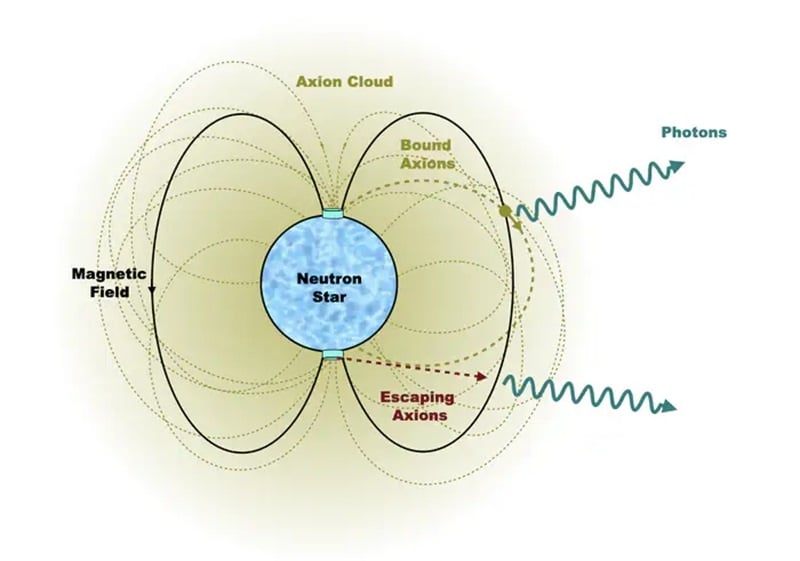Since the 1960s, astronomers have theorized that the Universe may be filled with a mysterious mass that only interacts with "normal matter" via gravity. This mass, nicknamed Dark Matter (DM), is essential to resolving issues between astronomical observations and General Relativity. In recent years, scientists have considered that DM may be composed of axions, a class of hypothetical elementary particles with low mass within a specific range. First proposed in the 1970s to resolve problems in the Standard Model of particle physics, these particles have emerged as a leading candidate for DM.
In addition to growing evidence that this could be the case, researchers at CERN are developing a new telescope that could help the scientific community look for axions - the CERN Axion Solar Telescope (CAST). According to new research conducted by an international team of physicists, these hypothetical particles may occur in large clouds around neutron stars. These axions could be the long-awaited explanation for Dark Matter that cosmologists have spent decades searching for. What's more, their research indicates that these axions may not be very difficult to observe from Earth.
The team was led by Dion Noordhuis, a Ph.D. student with the GRavitational AstroParticle Physics Amsterdam (GRAPPA) Institute, the Institute for Theoretical Physics (ITP), and the Delta Institute for Theoretical Physics at the University of Amsterdam (UvA). He was joined by researchers from Princeton University's Center for Theoretical Science (PCTS), the University of Barcelona, and the Rudolf Peierls Centre for Theoretical Physics at the University of Oxford. The paper that describes their findings was published on October 17th, 2024, in the journal Physical Review X.
Like DM, the existence of axions was postulated to address gaps in our understanding of the behavior of another elementary particle—the neutron. However, also like DM, these hypothetical particles have not yet been detected after decades of investigation. This is understandable since, if such particles exist, they would be extremely light, making them very hard to detect through experiments or astronomical observations. This is why axions are considered a promising candidate to explain DM, which theoretically accounts for 85% of matter in our Universe.
While DM is theorized to interact with visible matter via gravity, this does not necessarily mean that it has no other interactions that could be detectable. For example, axions are expected to convert into photons when exposed to electric and magnetic fields, which we can observe. However, the corresponding interaction strength and the amount of light produced should be very small. Therefore, they would likely go unnoticed unless there were an environment containing massive clouds of axions in a very strong electromagnetic field.
This led Noordhuis and his team to consider neutron stars since they are the densest class of stars in the Universe and generate very powerful electromagnetic fields. In fact, neutron stars generate magnetic fields that are billions of times stronger than Earth's magnetosphere. What's more, astronomers have used supernovae and cooling neutron stars for some time to constrain the properties of axons, including their mass and interactions with other particles. Recent research also supports the idea that their powerful magnetic fields allow neutron stars to produce huge amounts of axions near their surfaces.
In a previous study, Noordhuis and his colleagues investigated how axions could escape from a neutron star. This included computing the number of axions produced, which trajectories they would follow, and how their conversion into light could lead to an observable signal. In their latest work, the researchers focused on the axions theoretically captured by a neutron star's gravity. Due to the very weak nature of their interactions, these particles will likely remain bound to their stars for millions of years.
As they argue in their paper, they would gradually form a hazy cloud around the neutron star that could be visible to telescopes. The team also studied the formation, properties, and evolution of these axion clouds and found that (accounting for a wide range of axion properties) they would likely form around most, or even all, neutron stars. They also calculated that these clouds would be up to twenty orders of magnitude larger than local DM densities, producing powerful observational signatures.
These could come in the form of a continuous signal emitted during much of a neutron star's life or as a one-time burst of light at the end of its life. These signatures would be detectable by current radio telescopes and could be used to probe the interaction between axions and photons. While no axion clouds have been observed yet, the team's study offers astronomers parameters on what to look for. In addition to searching for axion clouds, this research presents additional opportunities for further theoretical research.
This includes follow-up work by one of the study's co-authors on how the axion clouds can change the dynamics of neutron stars themselves. There's also the possibility of exploring the numerical modeling of axion clouds to further constrain what and where astronomers should be looking. Finally, the present paper addresses single neutron stars, but there are also possibilities for binaries consisting of two neutron stars and a neutron star with a black hole companion. Taking advantage of next-generation instruments, in addition to current ones, these observations could be a step toward finding the elusive DM particle.
These studies could also have applications in other fields of research, such as particle physics, astrophysics, plasma physics, and radio astronomy. In short, this latest study presents opportunities for cross-disciplinary research that could resolve some of the greatest mysteries in astronomy and cosmology today.
*Further Reading: University of Physics*
 Universe Today
Universe Today

